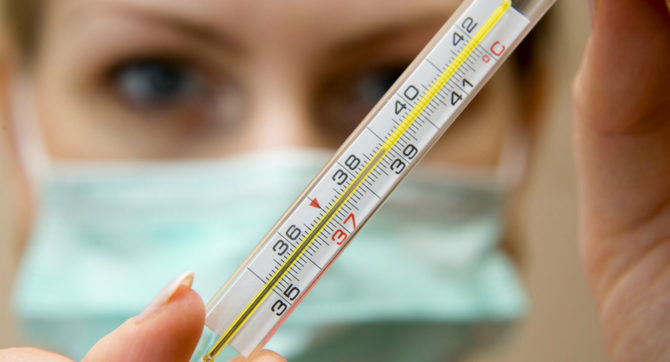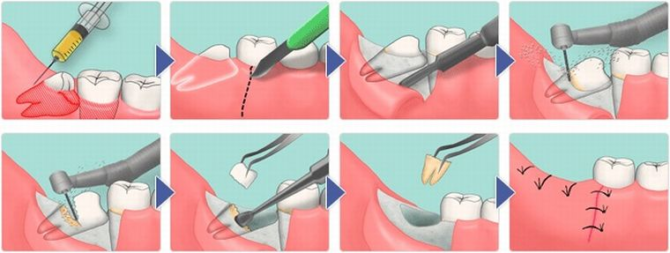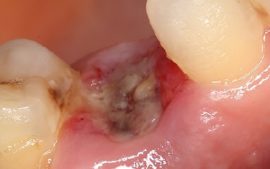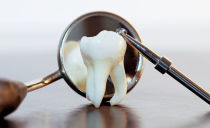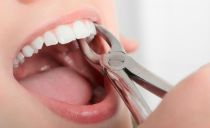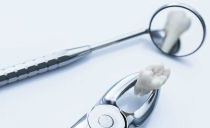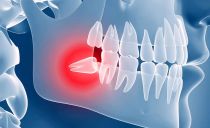What to do if temperature rises after tooth extraction
Most people start to panic if a temperature appears after tooth extraction. In order for the patient to be calm, you should study the information that will be presented in this article. If the temperature rises after tooth extraction, then this does not always mean serious problems.
Content
When fever is acceptable
When a tooth is removed from the hole, the dentist injures the soft tissues, causing bleeding. The human body is pretty smart. Inflammation appears as a response, including pain, redness, swelling, and fever.
After tooth extraction, a temperature in the range of 37 ° C is normal if it lasts for a short time. The immunity reacted on time and it is not worth panicking, and antibiotics are not required.
Fever on the day of removal
The temperature after tooth extraction may vary. Often it varies between 36.6–37ºС. In the evening, it can increase, which is the norm. There are cases of increase to 38ºС. If a person is exhausted and chills, then it is best to give him a drug that will relieve heat. Painkillers are used only if if there is pain. But after a simple removal, the pain most often does not occur.
The condition normalizes after a certain period of time, which usually ranges from 1 to 3 days.
Severe complications on the second day are not excluded, in which an increase in body temperature indicates certain problems.
If the patient has a cold
It should be noted that if a lot of damage was done during removal, the likelihood that the temperature rises is extremely high. If after three days there is no improvement, then you need to pay increased attention to this. It happens that the patient caught a cold or flu. These diseases appear from hypothermia or a viral infection.
Other symptoms, such as a sore throat, as well as cough, chills, runny nose, and redness of the eyes, join in. In this case, if the temperature has risen after tooth extraction, only a doctor will tell you what to do.
Temperature after removing a wisdom tooth
Often after removing the wisdom tooth, the temperature rises. The following symptoms also appear that you need to pay attention to:
- fever (38 ° C and higher) lasts more than three days with a maximum in the evening.
- at the removal site there is pain;
- there is inflammation and redness in the hole;
- there is no blood clot at the site of vomiting;
- manifestation of severe headache.
Each sign can appear gradually and disappear after some time. Sometimes they may not appear at all (headaches). The growing pain syndrome after the removal of a wisdom tooth along with an increase in temperature indicates a complication. Such an abnormal process should be stopped as soon as possible.
Pulling out the eight, you can almost always expect an increase in temperature. After removal of the third molar, the body also often gives a response.Therefore, it is rather difficult to remove these teeth, as they are located in a hard-to-reach area. The task is complicated if the teeth are retarded or dystopic.
The tooth extraction process is structured as follows:
- first, local anesthesia is done (using an injection);
- the gum is excised;
- bone tissue is drilled;
- Sawed (if necessary) and the tooth is removed;
- sutures are applied and the wound is treated.
It can be added that patients often complain of swelling of the gums, sharp pains and swelling of the cheeks.
Milk teeth
In the event that the temperature rises after tooth extraction in a child, you should visit a doctor for advice. Such teeth fall out on their own - this is normal. Therefore, the removal of such a tooth is not difficult. It is not necessary to wait three days before the condition of the child is normalized. If the temperature appears after removing the baby tooth in the child, you should definitely visit the dentist.
There are a number of reasons why a fever may occur after extraction of milk teeth in children:
- individual reaction of the body to outside interference;
- an inflammatory process develops in the soft tissues.
Possible complications
The manifestation of complications is sometimes very life-threatening. Severe fever may indicate a serious pathological process. A complication may occur due to the following:
- parts of the tooth or its root were not completely removed from the socket (toothache at the extraction site is possible);
- the appearance of alveolitis;
- hematoma development;
- due to chronic periodontitis and sinusitis.
The root or part of the bone remains in the hole
This type of complication appears due to improper actions by the dentist. The immune system responds quickly to this phenomenon. After a certain period of time, the root and the remaining bone part are covered on all sides by a tissue (root granuloma) that does not have a cavity. After a while, it transforms into a cystogranuloma, and then into a cyst. In the cyst itself, there are fat and protein tissues.
Sometimes the cyst bursts. Basically, this happens with periodontitis, injuries, colds, sinusitis. This phenomenon is accompanied by an increase in body temperature up to 39 ºС. The patient feels poorly, the gums swell, swelling of the cheeks and pain appear. Similar symptoms can occur up to three days.
Alveolite
Alveolitis is a disease in which the hole walls become inflamed. With this ailment, high temperature after tooth extraction manifests itself most often. After tooth extraction, the disease occurs quite often on the second day. You can highlight certain root causes that contribute to the development of alveolitis:
- non-compliance with the rules for care in the postoperative period;
- decay of a blood clot in a hole;
- there is no blood clot;
- excessive trauma during surgery;
- the appearance of severe bleeding in the hole;
- caries;
- purulent tonsillitis;
- pushing infected tissue into a well during surgery;
- weakened immune system.
In the event that any of the above factors is present, then the alveolitis may appear in a couple of days or even earlier. Concomitant signs of the disease are the presence of an unpleasant odor in the oral cavity, a feeling of powerlessness, acute pain in the operated area, as well as severe fever.
If timely measures are not taken, then the disease may go into the necrotic stage with purulent discharge. As a result, osteomyelitis develops. Symptoms of this disease:
- difficulty opening the mouth (if the tooth has been removed from the bottom row);
- temperature rises to 40ºС;
- the patient practically does not move, since there are no forces for working capacity;
- throbbing pain;
- fetid breath;
- bad night sleep.
If you continue to ignore the symptoms, then an abscess and phlegmon develops, and subsequently death can occur.
Hematoma
After the tooth has been torn out and the temperature has risen, hematoma may appear on the soft tissues. It appears if the vessel bursts due to increased fragility of the capillaries and hypertension.
Hematoma is determined by enlarged gums, pronounced pain, redness and fever.
Chronic periodontitis
With periodontitis, mainly after removal, pathogens remain in the hole. As a result, the temperature can reach 37.5ºС, and soft tissues swell and hurt.
Sinusitis
Often after a tooth is extracted, a runny nose develops and blood flows from the nose. The reason for these phenomena is the upper canine. The fact is that the maxillary sinuses lose their integrity, in connection with which food particles fall into the formed holes. The result is severe fever and inflammation. Also, patients usually feel heaviness and pulling pain in the nose, forehead and nose. Pain in these areas may not pass for a long time.
Other reasons
There are other reasons why the temperature rises after tooth extraction:
- an allergic reaction to local anesthesia;
- infection in the wound;
- when the dentist touches the root of the adjacent tooth;
- if a foreign object was left in the wound.
When should you bring down the temperature?
Most doctors agree that the temperature should be knocked down at any course of the process. Why do you need to do this? Too strong a heat that does not pass for a long time can disrupt the functioning of many organs. But you need to consider some points:
- Low temperature (37.2ºС-38ºС) should not go astray, since with this range, the body can cope with the infection itself.
- If, after tooth extraction, the temperature is 38 ° C or higher, then an antipyretic agent (aspirin, paracetamol, ibuprofen) should be taken, regardless of the factors in which the fever appeared.
In the event that a small child has a fever, it is best to use rectal suppositories. They are suitable for adults, if taking tablets is impossible due to nausea and vomiting.
Visit doctor
The decision to see a doctor should not be based only on how many days the patient has a fever.
If side symptoms occur, you should immediately seek qualified medical help. Common symptoms:
- bad smell from the oral cavity;
- body temperature above 38ºС;
- increasing pain;
- swollen soft tissue with redness;
- swelling of the cheeks;
- inflamed lymph nodes;
- purulent lesion.
The doctor will ask questions and send him to an X-ray, which will give an idea of the causes of the protracted fever. You can see incompletely removed parts of the tooth or root, which will subsequently be removed. After the intervention, the affected area is treated with an antiseptic and a course of antibiotic therapy is prescribed.
In case of detection of granulomas and cysts, the doctor works according to a similar scheme. If the walls of the cheeks or gums were injured during the first visit to the dentist, the doctor will decide to stitch. Also, the doctor can smooth the sharp bones that were left during the first dose with a special tool. If the temperature rises after tooth extraction, then you need to do everything that the doctor prescribed.
It must be borne in mind that repeated surgery will provoke a fever, but this is permissible.
Postoperative period
Prevention after surgery consists of the following actions:
- antiseptic treatment;
- sanitation;
- adherence to oral hygiene;
- alternative methods can be used several days after the operation.
Traditional medicine offers tinctures and decoctions of calendula, chamomile, St. John's wort, sage and calamus as mouthwashes that you can buy or make yourself.Such a technique should be supportive. in combination with drug treatment.
It must be added that the day before removal, you should refuse to visit the bathhouse, avoid the use of hot and cold food, be careful of drafts and not contact with sick people. It is not allowed to eat too hard foods that can harm the gums, as well as not to drink alcoholic beverages and seasonings. You also need to follow all the instructions of the doctor how tedious they would not be, so that the rehabilitation process is not long.

